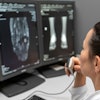A doctor doesn't decide on a patient's treatment regimen by evaluating the patient's symptoms alone. Instead, the diagnosis depends on the patient's clinical history, physician interpretation, test availability, and, in many cases, medical imaging.
 John Memarian, vice president of imaging technology and informatics at CitiusTech.CitiusTech
John Memarian, vice president of imaging technology and informatics at CitiusTech.CitiusTech
Imaging data forms the basis for decisions across specialties. It guides surgical planning, supports cancer staging, enables early identification of neurological conditions, and monitors treatment response. In each case, the treatment decision is dependent on how the image captures the clinical reality. Yet image fidelity receives relatively little attention outside of equipment specification sheets or postscan quality checks.
While most scans meet minimum technical criteria and are accepted into workflow, variations in sharpness, contrast, or subtle motion artifacts can affect how easily the image can be interpreted. When clarity is reduced, even slightly, interpretation may take longer or require additional comparison, and in high‑volume imaging environments, small drops in fidelity can lead to cumulative reporting delays, requests for secondary review, and occasional retakes.
Why image fidelity is a matter of life and death
Inconsistent image quality can lead to longer reporting times. When a region of interest is not well‑defined, radiologists or other interpreting clinicians may need to adjust settings, compare with earlier studies, or review additional sequences. These steps add time to the reporting process, especially when findings are subtle or unclear.
In some cases, decisions are delayed. A clinician may wait for further clarification before recommending treatment or moving forward with a procedure. This can affect patients who are in acute care, as well as those with conditions that require early intervention.
Hospitals and imaging centers also experience the effects. When images are questioned or need follow‑up, the result is more work for staff and additional scans for patients. These scenarios also increase resource use, particularly in settings where teams already manage a high volume of cases.
Image quality is often assumed to be acceptable if a report is generated. In practice, some scans meet technical standards but still create friction in the workflow. This slows down decisions and reduces overall efficiency, even when the delays are not recorded.
How image quality gets evaluated
Many imaging teams follow standard protocols for evaluating image quality, though the depth and consistency of these checks vary widely across facilities and specialties. These protocols include technical parameters like sharpness and noise levels, and practical checks for motion, artifacts, or incorrect field of view. If something looks off, the scan may be repeated or flagged.
However, subtle quality issues often slip past these steps and rarely show up in system reports unless they stop a diagnosis entirely. When an image is just clear enough to report but not ideal, the challenges stay hidden. They show up in longer reads, delayed interpretations, or follow‑up imaging that may not have been necessary.
There is also variation seen across sites. Some departments rely primarily on technologist or operator judgment, while others incorporate automated quality checks. A smaller subset has embedded review processes to monitor consistency over time. However, there is no universally enforced framework across all facilities or imaging platforms.
As a result, many image quality concerns get addressed informally, through second opinions, clarifications, or requests for additional views. These decisions happen on the fly and often remain invisible in official records.
Embedding quality into daily workflows
Besides a few leading institutions, many healthcare institutes do not have a system in place to routinely track how image fidelity affects interpretation, reporting time, or confidence in diagnosis, even today.
A growing number of health systems are beginning to monitor these patterns. Some have added feedback tools into reporting workflows, while others use structured templates to flag scans that need review. Early adopters are also experimenting with AI tools that detect issues such as missing slices, motion blur, or poor contrast before the case is opened for interpretation.
The goal isn't to add more steps or controls. It's to make fidelity a visible part of the reporting process, supporting interpreting clinicians, rather than treating it as a one‑time, front‑end check.
Clarity enables confidence
Clear medical images help clinicians complete their work more efficiently. When details are easy to see, the report is faster to write, and the findings are easier to explain. This makes communication with the clinical team more direct and helps speed up decisions.
Unclear images slow things down. A clinician may spend extra time checking a region, adjusting the view, or comparing it with earlier scans. These actions are part of the job, but when they happen often, they affect how quickly care can move forward.
Good image quality supports every part of the reporting process. It allows the clinician to stay focused. It improves the quality of reporting. It also helps the wider team make better use of each scan.
Improving fidelity doesn't require major changes. It starts with treating image quality as part of the workflow, not just a result of the machine. When image quality is consistent, the rest of the system benefits.
The bottom line
Image fidelity often remains in the background when everything goes as planned. Minor drops in clarity tend to show up not as system failures but as extra time spent reviewing, adjusting, or confirming. These slowdowns may be subtle, but they affect how quickly and confidently decisions are made.
Routine attention to image quality (where feasible) can help identify where reporting gets delayed or where clarity breaks down. While not all facilities have the resources to implement advanced monitoring, even incremental improvements can reduce friction and improve diagnostic confidence.
It is imperative to note that confidence in care improves when the information is precise. A reliable scan gives every decision a stronger starting point.
John Memarian is vice president of imaging technology and informatics at CitiusTech.
The comments and observations expressed herein do not necessarily reflect the opinions of AuntMinnie.com, nor should they be construed as an endorsement or admonishment of any particular vendor, analyst, industry consultant, or consulting group.




















